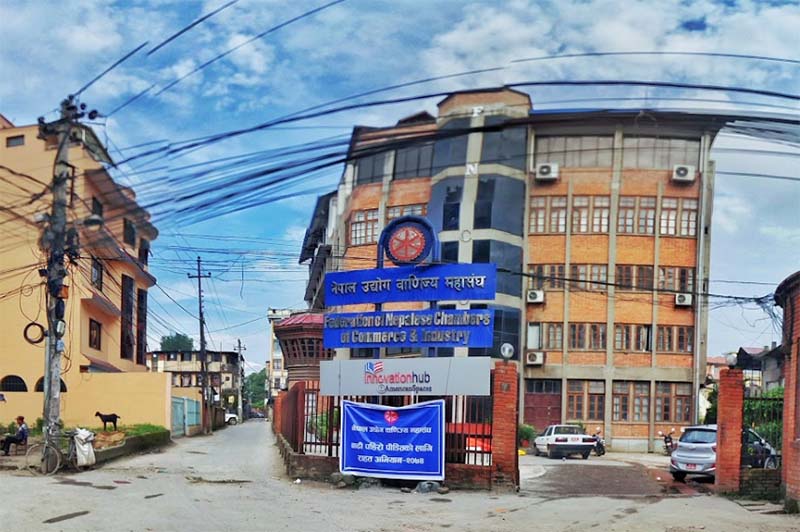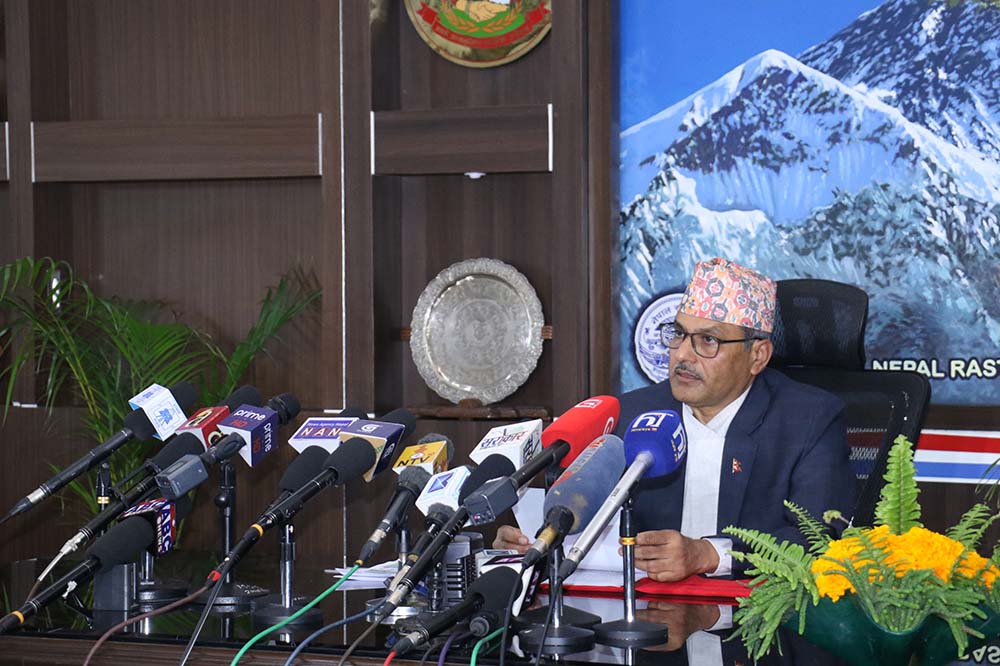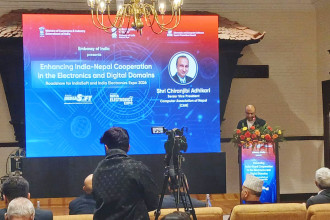
KATHMANDU: The monetary policy has been predicted to create more pressure on the liquidity situation seen in the market for about eight months, the Federation of Nepalese Chambers of Commerce and Industry (FNCCI) said in a review of Monetary Policy 2022/23.
The monetary policy was unveiled by Nepal Rastra Bank Governor Maha Prasad Adhikari, on Friday.
[caption id="attachment_26556" align="alignnone" width="1000"] Nepal Rastra Bank (NRB) Governor Maha Prasad Adhikari unveils the Monetary Policy 2022/23 in Kathmandu, on Friday, July 22, 2022. Photo: RSS[/caption]
The central bank which is looking forward to providing fewer loans by about 7% points than last year, has adopted a policy of maintaining liquidity from the market and increasing the interest rate of loans by reducing consumption, FNCCI reviewed.
The policy tends to control the debt and cut expenses rather than increasing the source of foreign exchange earnings. The private sector's organisation has welcomed the provisions such as reducing the interest rate of loans in the productive sector compared to other businesses, maintaining re-loan facilities for businesses hit hard by the Covid 19 pandemic, and realignment facilities for small entrepreneurs. However, but due to the lack of concrete measures to reduce the lack of capital, the monetary policy could not encourage the private sector, FNCCI opined.
The policy has not been able to cover the concrete measures of import substitution and export promotion. It will be challenging to achieve the economic growth rate of 8% in the annual budget as the private sector investment will also shrink due to the austerity policy.
The compulsory cash balance of 3% has been increased to 4%. This will bring in about Rs 50 billion to the central bank. Likewise, if the statutory liquidity ratio is increased by two percentage points, the additional amount will go from the banks to the central bank. When the bank rate increases from 7% to 8.5%, it will lead to an increase in the interest rate, according to FNCCI.
In the case that the deposits have not increased even when the interest rate is increased, these provisions will only allow the loan interest rate to increase. Construction of hydropower, tourism and other projects will also be affected as approved loans cannot be obtained due to a lack of investable funds.
Although credit is expensive due to strict policies, it is not easy to keep inflation within the desired limits only through monetary instruments.
Likewise, the reforms in the stock market have addressed small investors. Previously, the system of borrowing 40 million from a single financial institution and 120 million from the entire financial system has been revised to 120 million that can be borrowed from one financial institution.
Similarly, the risk weight of share loans up to Rs 2.5 million has been reduced from 150% to 100%. Some strict measures have been taken on unopened and overdraft loans.
It is said that loans will be provided at a lower rate in the productive sector than in the business sector. The central bank has addressed the demand raised by FNCCI for some time that there should be a difference between the loans to the productive and business sectors. For the time being, it has been arranged to charge 2% premium on loans up to 20 million based on food production, livestock, fisheries, exports and 100% domestic raw materials. Its concrete blueprint should come through the guidelines.
Entrepreneurs who have availed of loans of up to Rs 50 million will not be charged penal interest if they pay within October for the deadline of June/July. Also, it is said that the re-loan facility will be extended to the businesses most affected. This will make the situation easier for small entrepreneurs. But the FNCCI has demanded that refinancing be maintained by linking refinancing with productivity.
The policy, which mentions that alternative sources will be sought for startups, is silent on the possibility of giving project loans to small entrepreneurs. The Federation also requests for the implementation of project mortgage loans for the environment for the flourishing of small enterprises that have a large share in exports and have the potential for import substitution. FNCCI has already submitted its feasibility study report to the Central Bank last year.
The monetary policy mentions that concessions will be given with facilities to bring in remittances through formal channels. It is mentioned that card-to-card service will be provided. The new directive can only solve the problem at the practical level. It is positive that the policy has covered the issues of green economy and digital payments.
Regarding the lack of investable funds in the market, it is mentioned in the policy that banks and financial institutions (BFIs) should bring funds from abroad, bring in foreign investments, and encourage the savings of non-resident Nepalis. The federation has further drawn the attention of all stakeholders to the Country Rating issue mentioned in the government's policies and programmes which has not been covered by the annual budget and the monetary policy.
The private sector has opined that the existing system of keeping 20% liquidity can be modified. FNCCI has expressed it hope that guidelines will be issued to implement the plans mentioned in the policy.
READ ALSO:
Nepal Rastra Bank (NRB) Governor Maha Prasad Adhikari unveils the Monetary Policy 2022/23 in Kathmandu, on Friday, July 22, 2022. Photo: RSS[/caption]
The central bank which is looking forward to providing fewer loans by about 7% points than last year, has adopted a policy of maintaining liquidity from the market and increasing the interest rate of loans by reducing consumption, FNCCI reviewed.
The policy tends to control the debt and cut expenses rather than increasing the source of foreign exchange earnings. The private sector's organisation has welcomed the provisions such as reducing the interest rate of loans in the productive sector compared to other businesses, maintaining re-loan facilities for businesses hit hard by the Covid 19 pandemic, and realignment facilities for small entrepreneurs. However, but due to the lack of concrete measures to reduce the lack of capital, the monetary policy could not encourage the private sector, FNCCI opined.
The policy has not been able to cover the concrete measures of import substitution and export promotion. It will be challenging to achieve the economic growth rate of 8% in the annual budget as the private sector investment will also shrink due to the austerity policy.
The compulsory cash balance of 3% has been increased to 4%. This will bring in about Rs 50 billion to the central bank. Likewise, if the statutory liquidity ratio is increased by two percentage points, the additional amount will go from the banks to the central bank. When the bank rate increases from 7% to 8.5%, it will lead to an increase in the interest rate, according to FNCCI.
In the case that the deposits have not increased even when the interest rate is increased, these provisions will only allow the loan interest rate to increase. Construction of hydropower, tourism and other projects will also be affected as approved loans cannot be obtained due to a lack of investable funds.
Although credit is expensive due to strict policies, it is not easy to keep inflation within the desired limits only through monetary instruments.
Likewise, the reforms in the stock market have addressed small investors. Previously, the system of borrowing 40 million from a single financial institution and 120 million from the entire financial system has been revised to 120 million that can be borrowed from one financial institution.
Similarly, the risk weight of share loans up to Rs 2.5 million has been reduced from 150% to 100%. Some strict measures have been taken on unopened and overdraft loans.
It is said that loans will be provided at a lower rate in the productive sector than in the business sector. The central bank has addressed the demand raised by FNCCI for some time that there should be a difference between the loans to the productive and business sectors. For the time being, it has been arranged to charge 2% premium on loans up to 20 million based on food production, livestock, fisheries, exports and 100% domestic raw materials. Its concrete blueprint should come through the guidelines.
Entrepreneurs who have availed of loans of up to Rs 50 million will not be charged penal interest if they pay within October for the deadline of June/July. Also, it is said that the re-loan facility will be extended to the businesses most affected. This will make the situation easier for small entrepreneurs. But the FNCCI has demanded that refinancing be maintained by linking refinancing with productivity.
The policy, which mentions that alternative sources will be sought for startups, is silent on the possibility of giving project loans to small entrepreneurs. The Federation also requests for the implementation of project mortgage loans for the environment for the flourishing of small enterprises that have a large share in exports and have the potential for import substitution. FNCCI has already submitted its feasibility study report to the Central Bank last year.
The monetary policy mentions that concessions will be given with facilities to bring in remittances through formal channels. It is mentioned that card-to-card service will be provided. The new directive can only solve the problem at the practical level. It is positive that the policy has covered the issues of green economy and digital payments.
Regarding the lack of investable funds in the market, it is mentioned in the policy that banks and financial institutions (BFIs) should bring funds from abroad, bring in foreign investments, and encourage the savings of non-resident Nepalis. The federation has further drawn the attention of all stakeholders to the Country Rating issue mentioned in the government's policies and programmes which has not been covered by the annual budget and the monetary policy.
The private sector has opined that the existing system of keeping 20% liquidity can be modified. FNCCI has expressed it hope that guidelines will be issued to implement the plans mentioned in the policy.
READ ALSO:
 Nepal Rastra Bank (NRB) Governor Maha Prasad Adhikari unveils the Monetary Policy 2022/23 in Kathmandu, on Friday, July 22, 2022. Photo: RSS[/caption]
The central bank which is looking forward to providing fewer loans by about 7% points than last year, has adopted a policy of maintaining liquidity from the market and increasing the interest rate of loans by reducing consumption, FNCCI reviewed.
The policy tends to control the debt and cut expenses rather than increasing the source of foreign exchange earnings. The private sector's organisation has welcomed the provisions such as reducing the interest rate of loans in the productive sector compared to other businesses, maintaining re-loan facilities for businesses hit hard by the Covid 19 pandemic, and realignment facilities for small entrepreneurs. However, but due to the lack of concrete measures to reduce the lack of capital, the monetary policy could not encourage the private sector, FNCCI opined.
The policy has not been able to cover the concrete measures of import substitution and export promotion. It will be challenging to achieve the economic growth rate of 8% in the annual budget as the private sector investment will also shrink due to the austerity policy.
The compulsory cash balance of 3% has been increased to 4%. This will bring in about Rs 50 billion to the central bank. Likewise, if the statutory liquidity ratio is increased by two percentage points, the additional amount will go from the banks to the central bank. When the bank rate increases from 7% to 8.5%, it will lead to an increase in the interest rate, according to FNCCI.
In the case that the deposits have not increased even when the interest rate is increased, these provisions will only allow the loan interest rate to increase. Construction of hydropower, tourism and other projects will also be affected as approved loans cannot be obtained due to a lack of investable funds.
Although credit is expensive due to strict policies, it is not easy to keep inflation within the desired limits only through monetary instruments.
Likewise, the reforms in the stock market have addressed small investors. Previously, the system of borrowing 40 million from a single financial institution and 120 million from the entire financial system has been revised to 120 million that can be borrowed from one financial institution.
Similarly, the risk weight of share loans up to Rs 2.5 million has been reduced from 150% to 100%. Some strict measures have been taken on unopened and overdraft loans.
It is said that loans will be provided at a lower rate in the productive sector than in the business sector. The central bank has addressed the demand raised by FNCCI for some time that there should be a difference between the loans to the productive and business sectors. For the time being, it has been arranged to charge 2% premium on loans up to 20 million based on food production, livestock, fisheries, exports and 100% domestic raw materials. Its concrete blueprint should come through the guidelines.
Entrepreneurs who have availed of loans of up to Rs 50 million will not be charged penal interest if they pay within October for the deadline of June/July. Also, it is said that the re-loan facility will be extended to the businesses most affected. This will make the situation easier for small entrepreneurs. But the FNCCI has demanded that refinancing be maintained by linking refinancing with productivity.
The policy, which mentions that alternative sources will be sought for startups, is silent on the possibility of giving project loans to small entrepreneurs. The Federation also requests for the implementation of project mortgage loans for the environment for the flourishing of small enterprises that have a large share in exports and have the potential for import substitution. FNCCI has already submitted its feasibility study report to the Central Bank last year.
The monetary policy mentions that concessions will be given with facilities to bring in remittances through formal channels. It is mentioned that card-to-card service will be provided. The new directive can only solve the problem at the practical level. It is positive that the policy has covered the issues of green economy and digital payments.
Regarding the lack of investable funds in the market, it is mentioned in the policy that banks and financial institutions (BFIs) should bring funds from abroad, bring in foreign investments, and encourage the savings of non-resident Nepalis. The federation has further drawn the attention of all stakeholders to the Country Rating issue mentioned in the government's policies and programmes which has not been covered by the annual budget and the monetary policy.
The private sector has opined that the existing system of keeping 20% liquidity can be modified. FNCCI has expressed it hope that guidelines will be issued to implement the plans mentioned in the policy.
READ ALSO:
Nepal Rastra Bank (NRB) Governor Maha Prasad Adhikari unveils the Monetary Policy 2022/23 in Kathmandu, on Friday, July 22, 2022. Photo: RSS[/caption]
The central bank which is looking forward to providing fewer loans by about 7% points than last year, has adopted a policy of maintaining liquidity from the market and increasing the interest rate of loans by reducing consumption, FNCCI reviewed.
The policy tends to control the debt and cut expenses rather than increasing the source of foreign exchange earnings. The private sector's organisation has welcomed the provisions such as reducing the interest rate of loans in the productive sector compared to other businesses, maintaining re-loan facilities for businesses hit hard by the Covid 19 pandemic, and realignment facilities for small entrepreneurs. However, but due to the lack of concrete measures to reduce the lack of capital, the monetary policy could not encourage the private sector, FNCCI opined.
The policy has not been able to cover the concrete measures of import substitution and export promotion. It will be challenging to achieve the economic growth rate of 8% in the annual budget as the private sector investment will also shrink due to the austerity policy.
The compulsory cash balance of 3% has been increased to 4%. This will bring in about Rs 50 billion to the central bank. Likewise, if the statutory liquidity ratio is increased by two percentage points, the additional amount will go from the banks to the central bank. When the bank rate increases from 7% to 8.5%, it will lead to an increase in the interest rate, according to FNCCI.
In the case that the deposits have not increased even when the interest rate is increased, these provisions will only allow the loan interest rate to increase. Construction of hydropower, tourism and other projects will also be affected as approved loans cannot be obtained due to a lack of investable funds.
Although credit is expensive due to strict policies, it is not easy to keep inflation within the desired limits only through monetary instruments.
Likewise, the reforms in the stock market have addressed small investors. Previously, the system of borrowing 40 million from a single financial institution and 120 million from the entire financial system has been revised to 120 million that can be borrowed from one financial institution.
Similarly, the risk weight of share loans up to Rs 2.5 million has been reduced from 150% to 100%. Some strict measures have been taken on unopened and overdraft loans.
It is said that loans will be provided at a lower rate in the productive sector than in the business sector. The central bank has addressed the demand raised by FNCCI for some time that there should be a difference between the loans to the productive and business sectors. For the time being, it has been arranged to charge 2% premium on loans up to 20 million based on food production, livestock, fisheries, exports and 100% domestic raw materials. Its concrete blueprint should come through the guidelines.
Entrepreneurs who have availed of loans of up to Rs 50 million will not be charged penal interest if they pay within October for the deadline of June/July. Also, it is said that the re-loan facility will be extended to the businesses most affected. This will make the situation easier for small entrepreneurs. But the FNCCI has demanded that refinancing be maintained by linking refinancing with productivity.
The policy, which mentions that alternative sources will be sought for startups, is silent on the possibility of giving project loans to small entrepreneurs. The Federation also requests for the implementation of project mortgage loans for the environment for the flourishing of small enterprises that have a large share in exports and have the potential for import substitution. FNCCI has already submitted its feasibility study report to the Central Bank last year.
The monetary policy mentions that concessions will be given with facilities to bring in remittances through formal channels. It is mentioned that card-to-card service will be provided. The new directive can only solve the problem at the practical level. It is positive that the policy has covered the issues of green economy and digital payments.
Regarding the lack of investable funds in the market, it is mentioned in the policy that banks and financial institutions (BFIs) should bring funds from abroad, bring in foreign investments, and encourage the savings of non-resident Nepalis. The federation has further drawn the attention of all stakeholders to the Country Rating issue mentioned in the government's policies and programmes which has not been covered by the annual budget and the monetary policy.
The private sector has opined that the existing system of keeping 20% liquidity can be modified. FNCCI has expressed it hope that guidelines will be issued to implement the plans mentioned in the policy.
READ ALSO:
Published Date: July 26, 2022, 12:00 am
Post Comment
E-Magazine
RELATED B360 National





-1764255305.jpeg)